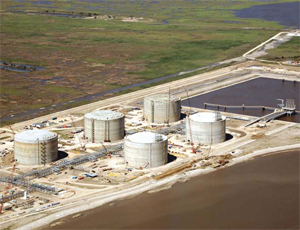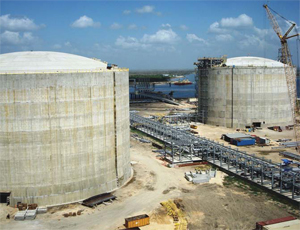The Golden Pass Liquefied Natural Gas Terminal is a massive five-tank project located in Sabine Pass. The terminal was developed to meet the rising demand for an energy source that is safe, lasting and reliable.
Once fully operational, the Golden Pass LNG Terminal will serve the growing natural gas need for the Texas Gulf Coast and other U.S. markets.


Baker Concrete Construction performed $89 million in concrete work, encompassing five complete liquefied nitrogen gas containment tanks. The job included the forming; reinforcing; place and finish of the base mats; tank walls; roof slabs; interior slabs; and sumps for the general contractor.
Baker began construction on the tanks in January 2006. Before the project started, the Baker team began work on detailed construction method statements for each phase of work, and it secured the material and proposed equipment.
Baker’s detailed schedule included other contractors and was a vital tool used on the project to help with coordination of hand-off points between different scopes of work. The schedule was instrumental in creating efficient progress on the project.
The tanks posed challenges at every stage of construction from the base slab to the roof, demanding unwavering attention and problem-solving from the Baker team. Each tank began with a 4-ft-thick base atop an expansive grid of precast piles that support the structure above.
Next, the 144-ft-high circular walls were constructed in nine, 15-ft-high consecutive lifts. Each lift required 12,800 sq ft of formwork, an average of 120 tons of rebar and 1,000 cu yds of concrete. The work was accomplished in 10-day cycles to meet an accelerated schedule.
Constructing a one-sided wall against a radial liner presented multiple challenges, including fitting the rebar mat against the liner curvature of the tank. To do the job, Baker came up with a system for fitting a flying radial truss. The rebar lifting frame allowed the rear mat and post-tensioning ducts to be installed on the ground, developing the radius for ease of installation of the rebar.
In order to complete the massive project within the 30-month schedule, Baker employed several strategies for increasing production. The preplanning and process engineering conducted at the outset of the project aided in shaving off much-needed days from the schedule. However, weather issues, critical path bottlenecks, and challenges coordinating multiple tanks still presented obstacles to efficient production.
Located at the edge of the Gulf Coast, the site faced heavy rains, blustery winds and extreme Texas heat. To combat the elements, Baker started wall pours and roof pours during the early morning and often worked on Satudays to make up for unexpected downpours or wind-out days during wall construction.
The jobsite was also subjected to unwelcomed visitors. As part of the swampy Texas coast, the area contained numerous snakes, mosquitoes and alligators. As with the wetlands, the animals were protected by the U.S. Environmental Protection Agency. If any animals wandered onto the jobsite, the team stopped work to call the environmental authorities for their safe removal to designated areas.
Key Players
Submitted by: Baker Concrete Construction
Owner: Golden Pass LNG Terminal LLC, Sabine Pass
General contractor/construction manager/architect: Chicago Bridge and Iron, Plainfield, Ill.
Rebar installer: CSC Steel Services, Houston
Post-tensioning installer: Schwager Davis Inc., San Jose, Calif.
Pump contractor: Brundage Bone Concrete Pumping, Houston
Reinforcing steel supplier: Nufab Rebar-Dayton LLC, Cincinnati

Post a comment to this article
Report Abusive Comment